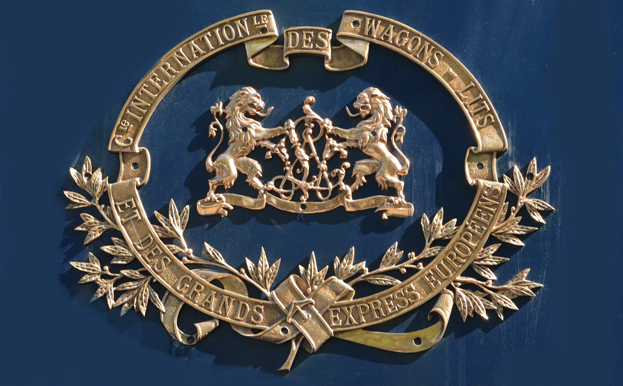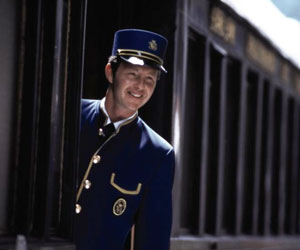History of the Venice Simplon-Orient-Express
The Venice Simplon-Orient-Express is still the most luxurious way to travel today. If you hear the words “Orient Express” they evoke thoughts of opulent carriages, glamour, luxury and a bygone, golden age. It captures the idea perfectly that “it is better to travel than to arrive”.
The legend began with the American George Mortimer Pullman, who we can thank for the concept of luxury train travel with his 1864 Pioneer that offered true comfort for rail passengers. His designs arrived in Britain in 1882 and from then on the word Pullman became a byword for luxury train travel in the UK. Around the same time the Belgian Georges Nagelmackers developed the Orient Express train, which was sumptuously decorated with rich furnishings and sparkling crystal, which ran originally between Paris and Romania.
In 1977, James B Sherwood, Chairman of Orient-Express Hotels, bought two of the original carriages at a Sotheby’s auction in Monte Carlo and set about meticulously restoring them. Over the next five years further Pullman and Wagons-Lit carriages were successfully found and the majestic new Venice Simplon-Orient-Express was launched on 25 May 1982. They consisted of a UK rake of umber and cream Pullman cars and a Continental rake of dark blue and gold Wagons-Lit carriages.
Travelling through some of Europe’s most spectacular scenery, the Venice Simplon-Orient-Express quickly became a unique train like no other, and one of the most loved and coveted travel experiences in the world.
 Georges Nagelmackers:
A young Belgian named Georges Nagelmackers was very impressed on his trip to the USA in 1867 by the Pullman night trains. He decided that on his return home he would establish such a network of trains in Europe, making them luxurious and able to travel across borders.
In 1874 Nagelmackers founded the Compagnie Internationale des Wagons-Lits (CIWL) the English translation is International Sleeping-Car Company; it is also known as just Wagons-Lits. It is an international hotel and travel logistics company specialising in catering and sleeping car services on board trains and is also the historical operator of the Orient Express.
At a time when travelling was still dangerous and uncomfortable, the Orient Express was a showcase in luxury and comfort and a network of luxury trains were soon expanded across Europe.
Then years later the et des Grands Express Europeens became part of the name and by 1886 his company was the main organiser for most European Heads of State. The symbol “WL” held by two lions became a well-known trade mark.
Orient Express A Brief History:
The first Express d’Orient left Paris for Vienna on 5 June, 1883, however, in 1891 the train was officially renamed Orient Express.
The original route was from Paris, Gare de I’Est to Giurgiu in Romania via Munich and Vienna. At Giurgiu the passengers were ferried across the Danube to Ruse, Bulgaria to pick up another train to Varna. The journey would then be completed to Istanbul by ferry. Two years later in 1885 another route opened up with passengers reaching Istanbul via rail from Vienna to Belgrade and Nis, carriage to Plovdiv and rail again to Istanbul. Then, four years later, the train’s eastern terminus became Varna in Bulgaria, where passengers could then sail onto Istanbul.
On 1 June, 1889 the first non-stop train to Istanbul left Paris and this remained its easternmost stop until 19 May, 1977. The eastern terminus was the Sirkeci Terminal by the Golden Horn. A ferry service would take passengers across the Bosphorus to Haydarpasa Terminal, the terminus of the Asian lines of the Ottoman Railways.
In 1914 WWI saw the Orient Express suspend its services but they were resumed at the end of the war in 1918. In 1919 the Simplon Tunnel was opened and this allowed the introduction of a more southerly route via Milan, Venice and Trieste. The service on this route was known as the Simplon Orient Express and it ran in addition to the old route. The Treaty of Saint-Germain contained a clause requiring Austria to accept this train. The Simplon Orient Express soon became the most important rail route between Paris and Istanbul.
It was during the 1930s that the Orient Express acquired its reputation for comfort and luxury, carrying sleeping cars and restaurant cars known for the quality of their service and cuisine. Royalty and the Upper Classes travelled on these trains with services including sleeping cars which ran from Calais to Paris, thus extending the service from one side of continental Europe to the other. There were three parallel services: the Orient Express, the Simplon Orient Express and the Arlberg Orient Express which ran via Zurich and Innsbruck to Budapest and had sleeper cars for the onward journey to Bucharest and Athens.
From 1939 until 1945 service was again interrupted as war raged across Europe once again with World War II. The German Mitropa company tried to run some services on the route through the Balkans but Yugoslav Partisans frequently sabotaged the tracks forcing this service to stop.
Normal services resumed following the end of the war except on the Athens route, where the closure of the border between Yugoslavia and Greece prevented services from running and there were other interruptions to services during this time. As the Iron Curtain fell across Europe the service did continue to run but the Communist countries increasingly replaced the Wagons-Lits cars with carriages run by their own railway services.
By 1962 the Orient Express and Arlberg Orient Express had stopped running, leaving only the Simplon Orient Express. This was replaced in 1962 by a slower service called the Direct Orient Express which ran daily cars from Paris to Belgrade and also twice weekly services from Paris to Istanbul and Athens.
The Wagons-Lits Company stopped running carriages itself in 1971 and making revenues from a ticket supplement. Instead it sold or leased all its carriages to the various national railway companies but continued to supply staff for the carriages. The direct service from Paris to Athens was withdrawn in 1976 and the last Paris – Istanbul Direct Orient Express ran for the last time on 19 May 1977.
A service under the name of the Orient Express continued to run from Paris to Budapest and Bucharest as before (via Strasbourg, Munich and Budapest). This continued until 2001 when the service was cut back to Paris to Vienna, the coaches for which were attached to the Paris-Strasbourg express. This service was continued with the timetables listing it under Orient Express until 8 June 2007. When the LGV Est Paris-Strasbourg high speed rail line opened on 10 June 2007 the Orient Express service was further cut back to Strasbourg – Vienna.
Orient Express further History and trivia:
The Orient Express made its debut in 1883 and was an instant success. The Ottoman Empire had been fashionable and interesting to the Upper Classes and Aristocracy across Europe for a long time and now there was a luxurious way of getting there.
In 1920 the President of France was Paul Deschanel and he found himself in an embarrassing situation when he stumbled off the train in his pyjamas and slippers. He reached the signal box and said to the two signal men “I am the President of France” to which one of them replied “And I am Emperor Napoleon”.
In 1929 there was a murder aboard the train while it was trapped in Turkey for six days in deep snow and this event inspired Agatha Christie’s famous book “Murder on the Orient Express”.
On another occasion the author herself was stuck on board for 24 hours due to floods.
Agatha Christie’s authorised biography quotes in full a letter to her husband detailing the event. The letter includes descriptions of some passengers on the train who influenced the plot of the book and in particular an American lady called Mrs Hilton, who was her inspiration for the character of Mrs Hubbard.
The book made the train service world famous but it acquired a different sort of fame during the Great War and WWII.
As the train went through so many different countries it became popular with spies as it allowed passengers to slip unnoticed across borders. Famous spies such as Mata Hari, who was executed in 1917 for her part in spying for the enemy were amongst its passengers and also the allied spy, Lord Robert Baden-Powell.
Lord Baden-Powell (better known to the world as the founder of the Boy Scouts) would travel on the train. He made sketches of butterflies but the intricate patterns in the wings of these insects were actually detailed drawings of the enemy fortifications that he had seen.
The actress Marlene Dietrich was a frequent traveller aboard the Orient Express. She would travel on board with Jean Gabin in particular, who was enlisted in the Free French Navy during the war. Afterwards they would travel together sharing a cabin on the Train Bleu.
Adolf Hitler took an interest in one of the carriages of the train, and that was because it had been used by the allies in 1918 as a conference room where the Germans had signed their surrender document on 11 November 1918.
After troops stormed Paris in 1940, Hitler ordered the same carriage to be brought to the place of the signing in 1918. Five years later, as his own defeat appeared inevitable the carriage was blown up to prevent it from becoming a symbol of Allied triumph.
The train has been associated with other writers and also the film industry. Graham Greene’s 1932 book “Stamboul Train” was based on the Venice-Simplon Orient Express and the novel was renamed “Orient Express” when it was published in the United States. Graeme Green wrote “in Stamboul Train for the first and last time in my life I deliberately set out to write a book to please, one which with luck might be made into a film. The devil looks after his own and I succeeded in both aims”. A film based on his book named Orient Express was made in 1934.
In 1963 the James Bond movie “From Russian With Love” sees Sean Connery strangle Donald “Red” Grant, played by Robert Shaw, with his own garrote aboard the Orient Express. The fight scene remains an all time classic with the famous quote from 007 “You won’t be needing this old man.”
The Spies Express:
The train earned the name “Spies’ Express” as secret agents seemed to love the train according to the historian Cookridge, writing “it made their jobs so much easier and their travels much more comfortable.” One of these secret agents was named Robert Baden-Powell and he made intricate sketches of the forms and colours of butterfly wings while posing as a lepidopterist in the Balkans. These sketches were actually coded representations of the fortifications he spotted along the Dalmation Coast, which were a great aid to the British and Italian Navy during The Great War.
Orient Express During The War:
The Orient Express service was severely limited during both World Wars, however, a single carriage played a fascinating symbolic role in both. On 11 November 1918 German Officers signed a surrender document in an Allied Commander’s Wagons-Lits car, which was used as a mobile conference room.
The French exhibited this carriage in Paris until June 1940 when Hitler ordered that it be moved to the exact place where the Germans had been forced to surrender 22 years before and there he dictated the terms of the French surrender. However, four years later when the war was not going well for Germany, Hitler ordered the carriage be blown up “lest it become a trophy of the Allies once more.”
Georges Nagelmackers:
A young Belgian named Georges Nagelmackers was very impressed on his trip to the USA in 1867 by the Pullman night trains. He decided that on his return home he would establish such a network of trains in Europe, making them luxurious and able to travel across borders.
In 1874 Nagelmackers founded the Compagnie Internationale des Wagons-Lits (CIWL) the English translation is International Sleeping-Car Company; it is also known as just Wagons-Lits. It is an international hotel and travel logistics company specialising in catering and sleeping car services on board trains and is also the historical operator of the Orient Express.
At a time when travelling was still dangerous and uncomfortable, the Orient Express was a showcase in luxury and comfort and a network of luxury trains were soon expanded across Europe.
Then years later the et des Grands Express Europeens became part of the name and by 1886 his company was the main organiser for most European Heads of State. The symbol “WL” held by two lions became a well-known trade mark.
Orient Express A Brief History:
The first Express d’Orient left Paris for Vienna on 5 June, 1883, however, in 1891 the train was officially renamed Orient Express.
The original route was from Paris, Gare de I’Est to Giurgiu in Romania via Munich and Vienna. At Giurgiu the passengers were ferried across the Danube to Ruse, Bulgaria to pick up another train to Varna. The journey would then be completed to Istanbul by ferry. Two years later in 1885 another route opened up with passengers reaching Istanbul via rail from Vienna to Belgrade and Nis, carriage to Plovdiv and rail again to Istanbul. Then, four years later, the train’s eastern terminus became Varna in Bulgaria, where passengers could then sail onto Istanbul.
On 1 June, 1889 the first non-stop train to Istanbul left Paris and this remained its easternmost stop until 19 May, 1977. The eastern terminus was the Sirkeci Terminal by the Golden Horn. A ferry service would take passengers across the Bosphorus to Haydarpasa Terminal, the terminus of the Asian lines of the Ottoman Railways.
In 1914 WWI saw the Orient Express suspend its services but they were resumed at the end of the war in 1918. In 1919 the Simplon Tunnel was opened and this allowed the introduction of a more southerly route via Milan, Venice and Trieste. The service on this route was known as the Simplon Orient Express and it ran in addition to the old route. The Treaty of Saint-Germain contained a clause requiring Austria to accept this train. The Simplon Orient Express soon became the most important rail route between Paris and Istanbul.
It was during the 1930s that the Orient Express acquired its reputation for comfort and luxury, carrying sleeping cars and restaurant cars known for the quality of their service and cuisine. Royalty and the Upper Classes travelled on these trains with services including sleeping cars which ran from Calais to Paris, thus extending the service from one side of continental Europe to the other. There were three parallel services: the Orient Express, the Simplon Orient Express and the Arlberg Orient Express which ran via Zurich and Innsbruck to Budapest and had sleeper cars for the onward journey to Bucharest and Athens.
From 1939 until 1945 service was again interrupted as war raged across Europe once again with World War II. The German Mitropa company tried to run some services on the route through the Balkans but Yugoslav Partisans frequently sabotaged the tracks forcing this service to stop.
Normal services resumed following the end of the war except on the Athens route, where the closure of the border between Yugoslavia and Greece prevented services from running and there were other interruptions to services during this time. As the Iron Curtain fell across Europe the service did continue to run but the Communist countries increasingly replaced the Wagons-Lits cars with carriages run by their own railway services.
By 1962 the Orient Express and Arlberg Orient Express had stopped running, leaving only the Simplon Orient Express. This was replaced in 1962 by a slower service called the Direct Orient Express which ran daily cars from Paris to Belgrade and also twice weekly services from Paris to Istanbul and Athens.
The Wagons-Lits Company stopped running carriages itself in 1971 and making revenues from a ticket supplement. Instead it sold or leased all its carriages to the various national railway companies but continued to supply staff for the carriages. The direct service from Paris to Athens was withdrawn in 1976 and the last Paris – Istanbul Direct Orient Express ran for the last time on 19 May 1977.
A service under the name of the Orient Express continued to run from Paris to Budapest and Bucharest as before (via Strasbourg, Munich and Budapest). This continued until 2001 when the service was cut back to Paris to Vienna, the coaches for which were attached to the Paris-Strasbourg express. This service was continued with the timetables listing it under Orient Express until 8 June 2007. When the LGV Est Paris-Strasbourg high speed rail line opened on 10 June 2007 the Orient Express service was further cut back to Strasbourg – Vienna.
Orient Express further History and trivia:
The Orient Express made its debut in 1883 and was an instant success. The Ottoman Empire had been fashionable and interesting to the Upper Classes and Aristocracy across Europe for a long time and now there was a luxurious way of getting there.
In 1920 the President of France was Paul Deschanel and he found himself in an embarrassing situation when he stumbled off the train in his pyjamas and slippers. He reached the signal box and said to the two signal men “I am the President of France” to which one of them replied “And I am Emperor Napoleon”.
In 1929 there was a murder aboard the train while it was trapped in Turkey for six days in deep snow and this event inspired Agatha Christie’s famous book “Murder on the Orient Express”.
On another occasion the author herself was stuck on board for 24 hours due to floods.
Agatha Christie’s authorised biography quotes in full a letter to her husband detailing the event. The letter includes descriptions of some passengers on the train who influenced the plot of the book and in particular an American lady called Mrs Hilton, who was her inspiration for the character of Mrs Hubbard.
The book made the train service world famous but it acquired a different sort of fame during the Great War and WWII.
As the train went through so many different countries it became popular with spies as it allowed passengers to slip unnoticed across borders. Famous spies such as Mata Hari, who was executed in 1917 for her part in spying for the enemy were amongst its passengers and also the allied spy, Lord Robert Baden-Powell.
Lord Baden-Powell (better known to the world as the founder of the Boy Scouts) would travel on the train. He made sketches of butterflies but the intricate patterns in the wings of these insects were actually detailed drawings of the enemy fortifications that he had seen.
The actress Marlene Dietrich was a frequent traveller aboard the Orient Express. She would travel on board with Jean Gabin in particular, who was enlisted in the Free French Navy during the war. Afterwards they would travel together sharing a cabin on the Train Bleu.
Adolf Hitler took an interest in one of the carriages of the train, and that was because it had been used by the allies in 1918 as a conference room where the Germans had signed their surrender document on 11 November 1918.
After troops stormed Paris in 1940, Hitler ordered the same carriage to be brought to the place of the signing in 1918. Five years later, as his own defeat appeared inevitable the carriage was blown up to prevent it from becoming a symbol of Allied triumph.
The train has been associated with other writers and also the film industry. Graham Greene’s 1932 book “Stamboul Train” was based on the Venice-Simplon Orient Express and the novel was renamed “Orient Express” when it was published in the United States. Graeme Green wrote “in Stamboul Train for the first and last time in my life I deliberately set out to write a book to please, one which with luck might be made into a film. The devil looks after his own and I succeeded in both aims”. A film based on his book named Orient Express was made in 1934.
In 1963 the James Bond movie “From Russian With Love” sees Sean Connery strangle Donald “Red” Grant, played by Robert Shaw, with his own garrote aboard the Orient Express. The fight scene remains an all time classic with the famous quote from 007 “You won’t be needing this old man.”
The Spies Express:
The train earned the name “Spies’ Express” as secret agents seemed to love the train according to the historian Cookridge, writing “it made their jobs so much easier and their travels much more comfortable.” One of these secret agents was named Robert Baden-Powell and he made intricate sketches of the forms and colours of butterfly wings while posing as a lepidopterist in the Balkans. These sketches were actually coded representations of the fortifications he spotted along the Dalmation Coast, which were a great aid to the British and Italian Navy during The Great War.
Orient Express During The War:
The Orient Express service was severely limited during both World Wars, however, a single carriage played a fascinating symbolic role in both. On 11 November 1918 German Officers signed a surrender document in an Allied Commander’s Wagons-Lits car, which was used as a mobile conference room.
The French exhibited this carriage in Paris until June 1940 when Hitler ordered that it be moved to the exact place where the Germans had been forced to surrender 22 years before and there he dictated the terms of the French surrender. However, four years later when the war was not going well for Germany, Hitler ordered the carriage be blown up “lest it become a trophy of the Allies once more.” 




